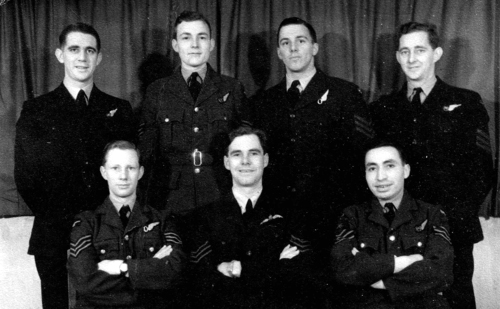
Sgt Ralph William Watson (418600 RAAF) — Navigator, Evader, and Tempsford Passenger
Sergeant Ralph William Watson, RAAF 418600, served as navigator with No. 166 Squadron RAF, based at Kirmington, flying Lancaster Mk I bombers on operations over occupied Europe.
On the night of 3/4 May 1944, Watson’s aircraft — Lancaster Mk I AS-Z (ME749), piloted by P/O Garnet Thomas Harrison RAAF (420749) — was one of many dispatched to strike the German army camp and rail yards at Mailly-le-Camp, France. As the bombers turned for home, Luftwaffe night-fighters pounced. Circumstantial evidence points to the aircraft being intercepted and shot down by Hauptmann Martin Drewes, a leading German night-fighter ace.
The Lancaster came down in occupied France. Of its seven-man crew:
-
P/O Garnet Harrison (RAAF) – Evaded capture
-
Sgt Ralph William Watson (RAAF) – Evaded capture
-
Sgt Jack Marsden (RAF) – Evaded capture
-
Sgt Robert Henry Haynes (RAF) – Evaded capture
-
F/O Geoffrey Vivian O’Brien (RAAF) – Captured, became PoW
-
Sgt Eric William John Ashford (RAF) – Captured, became PoW
-
Sgt Henry Pickford (RAF) – Killed in action
Evasion and rescue
Watson and his surviving comrades were hidden by French civilians and Resistance networks operating around the Rhône–Saône corridor. For three months he moved between safe houses, adopting false papers and relying on the courage of local families who risked their lives to shelter downed airmen.
As Allied advances pushed north in summer 1944, the Resistance began preparing escape routes for trapped fliers. Watson was grouped with other Allied evaders — including USAAF Staff Sergeant James J. Heddleston and Sergeant George W. Henderson from the B-24 Worry Bird, and two British airmen from a downed Lancaster, F/O John Tapp and Sgt John Troll — for extraction by the RAF’s secret transport unit, No. 161 (Special Duties) Squadron.
The night flight to freedom
On the night of 7/8 August 1944, a Lockheed Hudson (FK797) from 161 Squadron, piloted by Captain Wilkinson, landed on a clandestine field code-named LZ “Aigle”, near Asnières-sur-Saône (north of Mâcon). The reception party was led by Paul Rivière of the Free-French intelligence service (BCRA, “Galvani” network).
Waiting in the dark were senior Resistance and Free-French leaders — among them Jacques Chaban-Delmas, André Blumel, André Jarrot, and Émilienne Moreau-Évrard — and the mixed group of Allied airmen. The Hudson took off safely and reached RAF Tempsford in Bedfordshire before dawn.
Aftermath
Back in England, Watson and the others were debriefed by MI9, the Allied escape-and-evasion service. Records confirm he and the Canadian pilot F/Lt J. C. Trull (RCAF) were “flown back by Hudson of 161 (SD) Sqn from France 8 Aug 44 to Tempsford.”
Watson’s journey encapsulates the peril faced by bomber crews in 1944 and the extraordinary network of helpers — the maquis, SOE, BCRA, and 161 Squadron’s aircrews — that brought them home
Sources and References
-
RAF 166 Squadron Operational Record Book, AIR 27/1106 (May 1944), The National Archives (Kew) – details of Lancaster Mk I AS-Z (ME749) lost on operation to Mailly-le-Camp, 3/4 May 1944.
-
Commonwealth War Graves Commission and Australian War Memorial Roll – crew identifications for ME749; Sgt Henry Pickford (1321909 RAF) listed KIA.
-
MI9 Evasion & Escape Reports, WO 208/3337 and WO 208/3329, The National Archives – entries for Sgt R. W. Watson (418600 RAAF), P/O Garnet T. Harrison (420749 RAAF), F/O John Tapp (RAFVR), Sgt John Troll (RAFVR), and associated evaders.
-
Plan Sussex Project, Infiltrations into France, p. 64 – operation record for 7/8 Aug 1944 (161 Sqn Hudson FK797, Capt. Wilkinson, LZ “Aigle” near Asnières-sur-Saône) listing Free-French delegation and Allied airmen Heddleston, Henderson, Watson, Tapp & Troll. (http://www.plan-sussex-1944.net/anglais/pdf/infiltrations_into_france.pdf)
-
RAF 161 (Special Duties) Squadron ORB, AIR 27/1068/24 (Aug 1944) – confirms Hudson operations 7/8 Aug 44 “carried out successfully.”
-
U.S. War Department letter to Mrs Mary C. Collins, 14 Aug 1944, and Western Union telegram from S/Sgt James J. Heddleston, 20 Aug 1944 – corroborate date of exfiltration and arrival UK.
-
Local French account, 30 Jul 1969 (translation) – testimony from Saint-Cyr-de-Valorges Resistance families describing the evasion of “Jimmy Heddleson” and companions.
-
Secondary references:
• Jim Wright, On Wings of War: A History of 166 Squadron (pp. 73-74) – narrative of 166 Sqn loss ME749 and crew experiences.
• Aircrew Remembered database, entry for Lancaster ME749 AS-Z, 3/4 May 1944.
